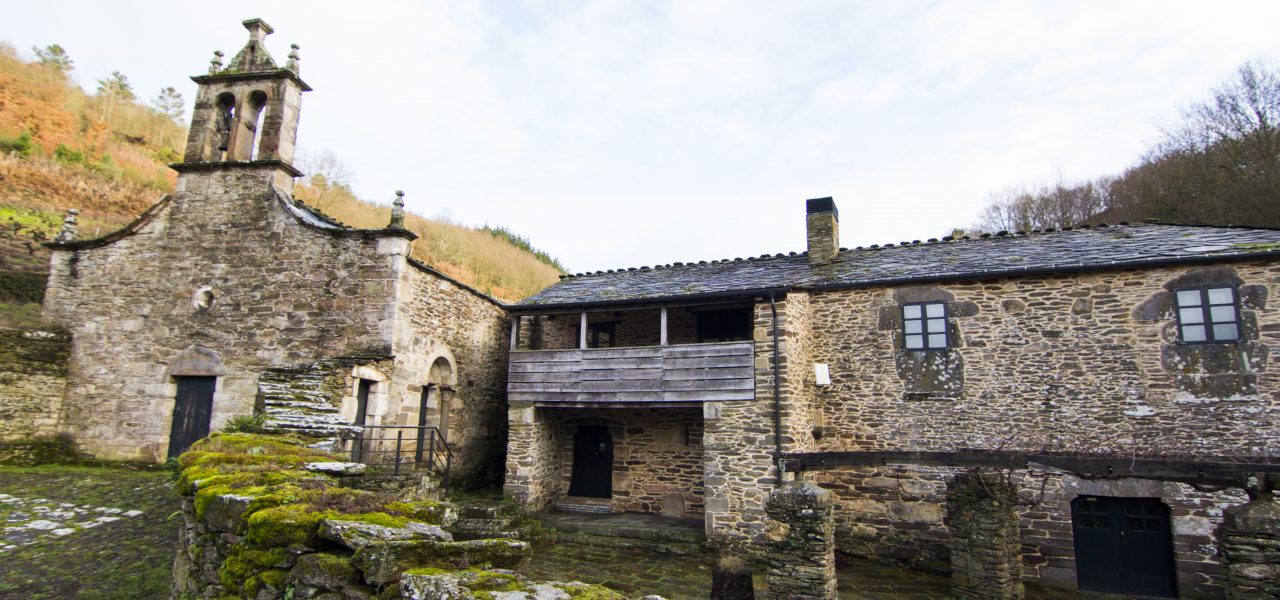INTRODUCTION
San Facundo is located in a beautiful spot, close to the river Miño and surrounded by vineyards. It was declared a National Monument in 1982. This ancient monastery was founded in the 12th century to accommodate the pilgrims who travelled to Santiago de Compostela. After the destruction of the bridge that crossed the river Miño in Portomarín by Doña Urraca, the Benedictine monks settled in this place of the Miño to cross the pilgrims by boat. When the bridge was rebuilt, travellers who could not afford paying a fee to cross the river in Portomarin took refuge in San Facundo.
HISTORY
The oldest reference is a donation document dating back to 1233, where it appears as Sancti Facundi de Ripa Minei. It was a Cistercian priory dependent on the abbot of the Monastery of Santa María de Castro de Rei de Lemos and the Monastery of Montederramo.
ARCHITECTURE AND FURNITURE
The most interesting part of the historical monument is the temple. Its Romanesque style is altered by Gothic elements and by evident signs of other refurbishments, as in the case of the shortened main nave, where a Baroque façade has been built. The church is simply decorated, with smooth modillions or decorated with very worn plant and zoomorphic motifs; in the apse, semicircular and with a straight section, part of the original with mutilated columns is still preserved. It preserves the old priory on the south side, which is accessed by a simple Romanesque door with a square- edged semicircular arch that rests on a smooth impost and capitals with worn decoration. In the interior, the hexagonal vault with quartersphere ribbing stands out. It also preserves wall paintings considered to be Hispano-Flemish dating back to the 15th century. On the North wall, San Cristobal with the Infant Jesus is depicted. In his belt, you can see the heads of three characters that represent travellers San Cristobal helped to cross the river. It is also San Bartolomé with half of skin hanging, recalling his martyrdom (was skinned alive) and stepping on a monster tied with a string. The other image we can see is Saint Francis of Assisi. It keeps the representation of the Crucifixion, the martyrdom of San Sebastian and the Virgin breast-feeding the child.
OPENING HOURS
Visits are allowed outside the monument.
A permit from the Bishopric is required to visit the monument.
CONTACT
Object:
O Lombao
Paradela
27611 Lugo, Galicia, Spain
Institution:
DIPUTACIÓN PROVINCIAL DE LUGO
Servicio de Turismo
San Marcos, 8
27001 Lugo
Galicia, Spain
Phone: +34 982 260 120
Email: turismo@deputacionlugo.org
ENTRANCE FEES & GUIDED TOURS
Visits are allowed outside the monument.
A permit from the Bishopric is required to visit the monument.
TOURIST INFORMATION OFFICE
RIBEIRA SACRA CONSORCIO DE TURISMO
Estrada de Viñoás, 3
32160 Nogueira de Ramuín
Ourense, Galicia, Spain
Phone: +34 638823592
Email: turismo@ribeirasacra.org


